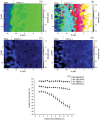Distinct photopolymerization efficacy on dentin of self-etch adhesives
- PMID: 22736445
- PMCID: PMC3398791
- DOI: 10.1177/0022034512452143
Distinct photopolymerization efficacy on dentin of self-etch adhesives
Abstract
The effect of application mode on polymerization effectiveness of self-etch adhesives with different pHs has rarely been studied. We applied 2 self-etch adhesives-Adper Prompt L-Pop (APLP, pH ~ 0.8) and Adper Easy-Bond (AEB, pH ~ 2.5)-to dentin with or without agitation (dynamic or static application), to investigate photopolymerization efficacy on dentin, and to understand the role of chemical interaction/reaction between adhesives and dentin. Micro-Raman spectra and imaging were acquired across the dentin/adhesive (D/A) interface. The degree of conversion (DC) of each adhesive as a function of position was calculated. SEM-EDS was used to obtain the elemental distribution along the interface. Photopolymerization efficacies of the two self-etch adhesives on dentin were apparently different. APLP exhibited decreasing DCs as the distance from the D/A interface became greater for both application modes, while the DCs for the dynamic mode were much higher than those for the static mode. As for AEB, the DCs remained almost constant across the adhesive layer and showed no significant difference between two modes. Raman spectral analysis disclosed that the chemical interaction between dentin and adhesives was responsible for the observations. We also verified this by tracking the distribution of the elements Ca and P in the adhesive layers.
Conflict of interest statement
The authors declare no potential conflicts of interest with respect to the authorship and/or publication of this article.
Figures




Similar articles
-
Effect of application mode on interfacial morphology and chemistry between dentine and self-etch adhesives.J Dent. 2013 Mar;41(3):231-40. doi: 10.1016/j.jdent.2012.11.006. Epub 2012 Nov 12. J Dent. 2013. PMID: 23153573 Free PMC article.
-
"No-bottle" vs "multi-bottle" dentin adhesives--a microtensile bond strength and morphological study.Dent Mater. 2001 Sep;17(5):373-80. doi: 10.1016/s0109-5641(00)00084-1. Dent Mater. 2001. PMID: 11445203
-
Immediate bonding properties of universal adhesives to dentine.J Dent. 2013 May;41(5):404-11. doi: 10.1016/j.jdent.2013.03.001. Epub 2013 Mar 14. J Dent. 2013. PMID: 23499568 Clinical Trial.
-
Degree of conversion of two-step etch-and-rinse adhesives: In situ micro-Raman analysis.J Dent. 2012 Sep;40(9):711-7. doi: 10.1016/j.jdent.2012.05.001. Epub 2012 May 11. J Dent. 2012. PMID: 22583674 Clinical Trial.
-
Which self-etch bonding systems are suitable for which clinical indications?Quintessence Int. 2013 Oct;44(9):645-61. doi: 10.3290/j.qi.a30182. Quintessence Int. 2013. PMID: 23971056 Review.
Cited by
-
Knoop Hardness of Self-Etch Adhesives Applied on Superficial and Deep Dentin.J Dent (Shiraz). 2020 Mar;21(1):42-47. doi: 10.30476/DENTJODS.2019.77805.0. J Dent (Shiraz). 2020. PMID: 32158783 Free PMC article.
-
Effect of application mode on interfacial morphology and chemistry between dentine and self-etch adhesives.J Dent. 2013 Mar;41(3):231-40. doi: 10.1016/j.jdent.2012.11.006. Epub 2012 Nov 12. J Dent. 2013. PMID: 23153573 Free PMC article.
-
Analysis of interfacial structure and bond strength of self-etch adhesives.Am J Dent. 2013 Dec;26(6):335-40. Am J Dent. 2013. PMID: 24640438 Free PMC article.
-
Direct Pulp Capping: Which is the Most Effective Biomaterial? A Retrospective Clinical Study.Materials (Basel). 2019 Oct 16;12(20):3382. doi: 10.3390/ma12203382. Materials (Basel). 2019. PMID: 31623190 Free PMC article.
-
Non-thermal atmospheric plasmas in dental restoration: improved resin adhesive penetration.J Dent. 2014 Aug;42(8):1033-42. doi: 10.1016/j.jdent.2014.05.005. Epub 2014 May 21. J Dent. 2014. PMID: 24859333 Free PMC article.
References
-
- Amaral RC, Stanislawczuk R, Zander-Grande C, Gagler D, Reis A, Loguercio AD. (2010). Bond strength and quality of the hybrid layer of one-step self-etch adhesives applied with agitation on dentin. Oper Dent 35:211-219 - PubMed
-
- Cadenaro M, Antoniolli F, Sauro S, Tay FR, Di Lenarda R, Prati C, et al. (2005). Degree of conversion and permeability of dental adhesives. Eur J Oral Sci 113:525-530 - PubMed
-
- Carvalho RM, Chersoni S, Frankenberger R, Pashley DH, Prati C, Tay FR. (2005). A challenge to the conventional wisdom that simultaneous etching and resin infiltration always occurs in self-etch adhesives. Biomaterials 26:1035-1042 - PubMed
-
- De Munck J, Vargas M, Iracki J, Van Landuyt K, Poitevin A, Lambrechts P, et al. (2005). One-day bonding effectiveness of new self-etch adhesives to bur-cut enamel and dentin. Oper Dent 30:39-49 - PubMed
-
- De Munck J, Shirai K, Yoshida Y, Inoue S, Van Landuyt KL, Lambrechts P, et al. (2006). Effect of water storage on the bonding effectiveness of 6 adhesives to class I cavity dentin. Oper Dent 31:456-465 - PubMed
Publication types
MeSH terms
Substances
Grants and funding
LinkOut - more resources
Full Text Sources
Research Materials

